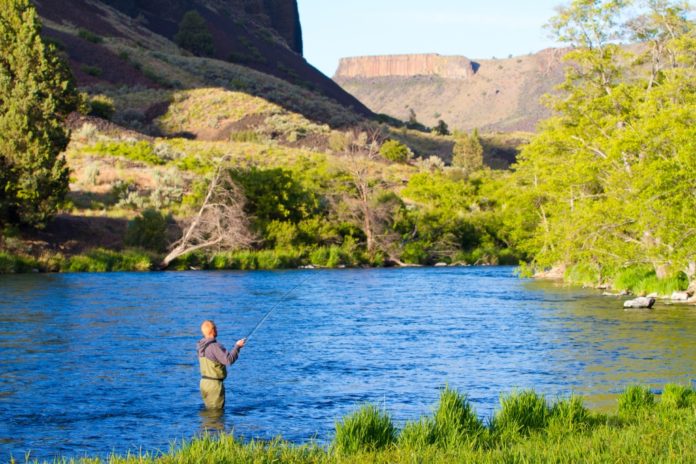CENTRAL OREGON — I had never touched a fly rod, let alone gone on a fishing trip. Yet, here I was, wading in the assertive waters of the Crooked River, tipping my line and watching it unfurl like a gymnast’s ribbon into glistening streams brimming with fish.
I’ve canoed Central Oregon’s alpine lakes and soared above the mountains of this high-desert paradise, but seeing it this way with my family was new and exhilarating. As we learned, the eight-mile Crooked River, a tributary of the Deschutes, is ideal for first-time anglers like us, because it’s overflowing with native Redband rainbow trout and mountain whitefish. The trout literally jump out of the water, their prismatic skin a kaleidoscope of color.
Wacky flow patterns can sometimes put the fish off for a day or two, but with the right flies, rigs and techniques — on this day, tension and roll casting — anyone can get a bite. For that expert eye, my husband and I turned to Justin Francis, a guide with Fly and Field Outfitters in Bend. Francis has been fly-fishing for 23 years. He once hooked an 85-pound tarpon in Florida using a 9-foot rod like mine, though his was twice as heavy.
A wealth of knowledge, Francis was patient and encouraging, especially with my 10-year-old, who was not yet convinced that standing in the middle of a gushing river for hours was his idea of a good time. Francis knew when to push, when to let us practice and how often to switch up our artificial flies.
On a day like this, when the fish were biting, he switched up the size, pattern and color of our flies fairly frequently. Gotta keep them guessing.
We had arrived in Bend a few days before, ate our way through the city’s trendy food pods and explored a lava tube cave used by Prohibition-era bootleggers. Now, surrounded by spectacular nature, it was time to conquer catch-and-release.
Our day started on the west side of town at Fly and Field’s shop, where the crew fitted us with waders and boots, selected our equipment and secured our licenses for the day. Then we jumped in our car and followed Francis east for about an hour, until the road dropped into a hidden canyon below the dam at Prineville Reservoir.
There, surrounded by a stunning caldera canyon, we parked, suited up and took our first steps into the river. As tailwater fisheries go, there’s no better classroom than the Crooked River. Year round, it has a staggering number of fish, at least one thousand per river mile. High water events in recent winters have caused some population decline, but Francis confirms the fish have made a comeback.

We spent most of the half-day Walk and Wade trip — almost four hours — in the river. Even when it started raining, we remained in the water, perfecting our tension cast: You dangle the line, face the fish and then slowly lift the rod and flick the tip forward, relying on the speed of the current. “It’s like a sling shot for your rod,” Francis explained. It’s an especially good technique “to keep you from tangling up all day” when there are multiple lines in the water.
I was the last to find my rhythm, but once I did, I found fly-fishing peaceful and intuitive, like tai chi, but on water. And when we each hooked a fish, Francis was there to capture the moment with his camera — “seeing our eyes light up with excitement,” he said — before freeing them. I asked him what 23 years of fly-fishing has taught him about life. He said to be patient, look around and enjoy the outdoors.
I could have stayed on the Crooked River longer, which is probably why Fly and Field and similar outfitters offer full-day trips, as well. Choosing the right trip and river depends on the season and how much time you have. Full-day trips include a streamside barbecue lunch, but even on our half-day adventure, we had time to share snacks and sandwiches.
Sitting there, chomping on a turkey and cheese amid ponderosa pines, watching the trout burst from the water, I was already thinking of my next time.
If You Go
Fly and Field Outfitters offers guided half-day (four hours) Walk and Wade fly-fishing trips starting at $375. Full day trips start at $525. Prices include rental rod, reel, waders and boots. Full-day trip prices include lunch. Find more information at www.flyandfield.com.
Find more travel suggestions for Bend, Redmond and Central Oregon here.
Credit: Source link































